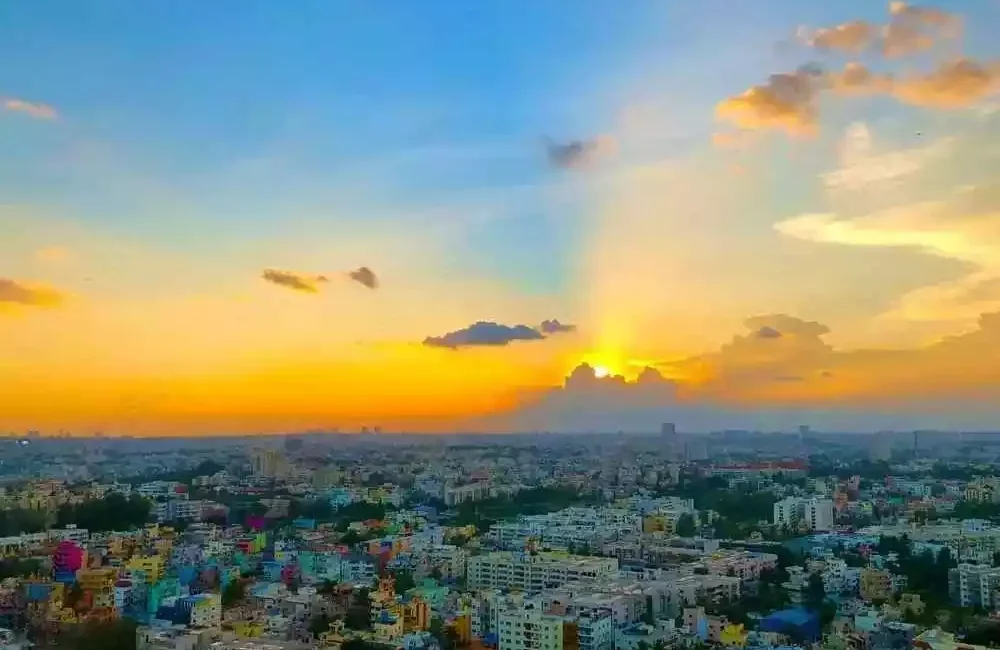Exploring the Vibrant Bengaluru Urban District
Bengaluru Urban District, the heart of India's Silicon Valley, is a bustling metropolis that blends modernity with rich heritage. This comprehensive guide delves into its demography, culture, geography, cuisines, history, literary contributions, and administrative setup, painting a vivid picture of this dynamic district.
Demography
Bengaluru Urban District is a melting pot of diverse cultures and communities. According to the latest census, the district has a population of approximately 12.3 million people. The district boasts a literacy rate of 88.71%, which is significantly higher than the national average.
Population Distribution
The district is divided into several zones:
- Bengaluru North: Known for its educational institutions and IT parks.
- Bengaluru South: A mix of residential areas and bustling markets.
- Bengaluru East: The industrial hub.
- Bengaluru West: Famous for its heritage sites.
The population is a blend of various ethnic groups, with a significant presence of Kannadigas, Tamilians, Telugus, and a sizeable number of expatriates.
Culture
Bengaluru Urban is a cultural hotspot. The city's cosmopolitan nature is reflected in its festivals, art, music, and theater.
Festivals
- Dasara: A grand celebration with processions and cultural performances.
- Karaga: A unique festival symbolizing the city's rich heritage.
- Bengaluru International Film Festival: Celebrates global cinema and local talent.
Arts and Music
- Ranga Shankara: A hub for contemporary theater.
- Lalbagh Flower Show: Showcases horticultural excellence.
- Carnatic Music: The district is home to numerous Carnatic music festivals and sabhas.
Geography
Located in the southern part of Karnataka, Bengaluru Urban spans an area of 2,196 square kilometers. The district's topography is characterized by flat to undulating terrain.
Climate
The climate is moderate, with distinct wet and dry seasons:
- Summer: March to May, with temperatures ranging from 20°C to 36°C.
- Monsoon: June to September, bringing heavy rainfall.
- Winter: October to February, with temperatures ranging from 14°C to 28°C.
Natural Features
- Lakes: Ulsoor Lake, Sankey Tank, and Hebbal Lake.
- Parks: Cubbon Park and Lalbagh Botanical Garden.
Cuisines
Bengaluru Urban is a paradise for food lovers, offering a variety of cuisines that cater to every palate.
Traditional Karnataka Cuisine
- Bisi Bele Bath: A spicy rice dish with lentils and vegetables.
- Ragi Mudde: Finger millet balls served with sambar.
- Mysore Pak: A famous sweet made of gram flour, sugar, and ghee.
Multicultural Flavors
The district's cosmopolitan nature is reflected in its wide range of international cuisines, from Italian to Japanese, alongside a thriving street food culture.
History
Bengaluru Urban has a rich historical tapestry that dates back to the 16th century.
Founding and Early History
- Kempe Gowda I: The city's founder, established it in 1537.
- Tipu Sultan: The Tiger of Mysore, who played a significant role in the district's history.
Colonial Era
Under British rule, Bengaluru became a major administrative and military center, which laid the groundwork for its transformation into a modern city.
Post-Independence
Post-1947, Bengaluru Urban emerged as a major industrial and IT hub, earning the moniker 'Silicon Valley of India.'
Literary Contributions
Bengaluru Urban has been home to many notable poets and authors who have enriched Kannada literature.
Prominent Figures
- Kuvempu: A Jnanpith awardee whose works are considered literary treasures.
- U. R. Ananthamurthy: Known for his critical insights into social issues.
Literary Festivals
- Bangalore Literature Festival: A platform for local and international writers to engage with readers.
- Atta Galatta-Bangalore Literature Festival: Celebrates literature in various Indian languages.
Administration
Bengaluru Urban District is administratively divided into four taluks: Bengaluru North, Bengaluru South, Bengaluru East, and Anekal.
Governance Structure
The district is governed by the Bruhat Bengaluru Mahanagara Palike (BBMP), which oversees urban planning, infrastructure development, and public services.
Key Administrative Bodies
- Bangalore Development Authority (BDA): Responsible for planning and development.
- Bangalore Water Supply and Sewerage Board (BWSSB): Manages water supply and sanitation.
- Bangalore Metropolitan Transport Corporation (BMTC): Provides public transportation services.
Economy
Bengaluru Urban is an economic powerhouse, with a GDP that surpasses many small countries.
IT and Technology
The district is home to over 3,500 IT companies, including global giants like Infosys, Wipro, and Tata Consultancy Services.
Start-up Ecosystem
Bengaluru is dubbed the 'Start-up Capital of India,' with a vibrant ecosystem that fosters innovation and entrepreneurship.
Manufacturing and Industries
Apart from IT, the district also has robust manufacturing, aerospace, and biotechnology sectors.
Education
Bengaluru Urban is renowned for its educational institutions, which attract students from across the globe.
Prestigious Institutions
- Indian Institute of Science (IISc): A premier research institution.
- Indian Institute of Management Bangalore (IIMB): One of the top business schools in Asia.
- National Institute of Fashion Technology (NIFT): Known for its fashion design programs.
Research and Development
The district is a hub for R&D activities, with numerous institutions and corporate R&D centers contributing to advancements in science and technology.
Tourism
Bengaluru Urban offers a plethora of tourist attractions, ranging from historical sites to modern marvels.
Major Attractions
- Bangalore Palace: A Tudor-style architectural marvel.
- Vidhana Soudha: The seat of the state legislature of Karnataka.
- ISKCON Temple: A major spiritual and cultural center.
Shopping and Entertainment
The district is dotted with shopping malls, markets, and entertainment venues, offering a mix of traditional and modern shopping experiences.
Diagram Suggestion
In conclusion, Bengaluru Urban District stands as a testament to India's progress and cultural richness. Its vibrant demography, diverse culture, strategic geography, delectable cuisines, illustrious history, literary heritage, robust administration, booming economy, esteemed educational institutions, and numerous tourist attractions make it a remarkable district. Whether you're a resident, a visitor, or a business, Bengaluru Urban offers an unparalleled experience that seamlessly blends the past, present, and future.
